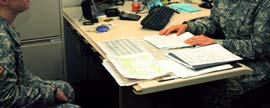AR 600-20 and FM 7-22 spell out the specifics of using physical fitness as a means of corrective training.
AR 600-20 paragraph 4-20, states the following with regard to using physical fitness training as corrective training:
When authorized by the chain of command and not unnecessarily cruel, abusive, oppressive, or harmful, the following activities do not constitute hazing: Administrative corrective measures, including verbal reprimands and a reasonable number of repetitions of authorized physical exercises. Extra military instruction or training. Physical training (PT) or remedial PT.
Notice the key aspects of this paragraph:
1. The action must be approved by the chain of command.
Author’s Note: Usually it is a good idea for a Commander to have a policy letter on how they expect corrective training to be implemented within their unit. It is not a requirement but good practice to ensure corrective training is standardized across the unit. Any such policy letter should be reviewed by JAG prior to implementation.
2. The corrective training will consist of a reasonable number of repetitions of authorized physical exercises. So how do you know what constitutes a reasonable number of repetitions? What are the authorized physical exercises that can be used for corrective training? To answer these questions we need to refer to FM 7-22 paragraph 5-15.
FM 7-22 paragraph 5-15 states:
When exercise is used for corrective action, it is often performed incorrectly, promoting overtraining syndrome, and overuse injuries. Often corrective action mimics “smoke sessions,” punishing Soldiers with little or no corrective value. Consideration must be given to the number of times per day exercises are used for corrective action for individual Soldiers and groups of Soldiers to avoid the cumulative effect and limit the potential for overtraining syndrome. The following guidelines should be followed when employing exercise as corrective action.
Only the following exercises should be selected for performance of corrective action: Rower, Squat bender, Windmill, Prone row, Push-up, V-up, Leg tuck and twist, Supine bicycle, Swimmer, 8-count push-up. Only one of the above exercises may be selected for each corrective action. The number of repetitions should not exceed FIVE for any one of the exercises listed above.
In summary only the exercises specified above can be used for physical corrective training, only one of the exercises may be selected for the specific corrective action, and the number of repetitions should not exceed 5. In the text above I purposely bolded the word “should.” I did this because the word “should” implies a leader may deviate from this list or number of repetitions. However, I would strongly advise against any deviation. My reason for this is simple. If the Army went through the trouble to outline these specific exercises and the number of repetitions they did so for a reason…to reduce the likelihood of injuries. In addition if you notice after the specific exercises are listed a directive sentence follows and it states: “Only one of the above exercises may be selected for each corrective action.” This sentence clearly articulates that only the specified exercises can be used. These standards were specifically developed to eliminate the use and implementation of “SMOKE SESSIONS.” Smoke Sessions are commonly referred to as corrective training in which physical exercises are used to exhaust and overwhelm a Soldier through the use of physical exercise. A “SMOKE SESSION” is punishment, not corrective training. Therefore it is inappropriate and in my opinion illegal. These sessions are both dangerous and unsafe. These types of sessions are unprofessional, abusive to the subordinate, and constitute hazing. They can result in leaders being charged under the UCMJ for abuse of subordinates, jeopardizing the safety of their subordinates, etc. Properly executed physical exercise can be a quick and motivating method to gain a Soldier’s attention. Improperly executed it can result in the Soldier sustaining serious injury, and/or result in leaders being charged with abuse of subordinates or hazing. If you stick to the rules and guidelines outlined in AR 600-20 and FM 7-22 you can’t go wrong.
NOTE: Keep in mind if you are a leader and you are incorrectly administering corrective training that involves physical training you can be held liable for any injury the Soldier sustains during these types of sessions.
TIP: If it looks like and smells like a “SMOKE SESSION” you should have used the reasonable person rule. Because odds are you are violating the intent of using physical training as corrective training. Use physical training wisely, as you are responsible for the health and welfare of the Soldier.
For More Information on corrective training read the Mentor














Comments
Nathin vann
Could you tell me when this regulation was updated to this? I’ve never seen this in those regulations and just want to know a more accurate date when it changed.
Mark Gerecht
This response is provided based on the information you shared and should not be used as the sole source for making a decision. You should seek guidance from the chain of command, IG, JAG or other certified agencies before making any decisions. How you chose to use this information is totally up to you and is your sole responsibility.
The regulations have changed. If you would like the most up to date information please see the following video:
https://youtu.be/7AdtQctMdDY
Please subscribe to our YouTube Channel: MENTOR MILITARY
HOPE THIS HELPS
Respectfully,
TOP aka WORF
CHECKOUT OUR YOUTUBE CHANNEL: Mentor Military https://www.youtube.com/channel/UCj0IXu7SmA2wLoPrNAUfSZA
FOLLOW US
Facebook/Twitter/Newsletter
Facebook: https://www.facebook.com/MentorMilitary/
Facebook: https://www.facebook.com/Asktop/
Newsletter: http://eepurl.com/bjcYH
YOUTUBE: Mentor Military https://www.youtube.com/channel/UCj0IXu7SmA2wLoPrNAUfSZA
Twitter: https://twitter.com/AskTOP
Websites:
http://www.MentorMilitary.com
http://www.Asktop.net
http://www.ArmyCounselingOnline.com
Jennifer
5 repetitions of one specific excercize…..wow.
I can’t form the words to begin to state how much I disagree with the 2021 regs.
The Army could have done away with the list of exercises on this list and instead inserted one – – The Flutterkick
Mark Gerecht
This information was updated as of 2021. Would encourage you to review the updates on our YouTube Channel Mentor Military.
HOPE THIS HELPS
Respectfully,
TOP aka WORF
CHECKOUT OUR YOUTUBE CHANNEL: Mentor Military https://www.youtube.com/channel/UCj0IXu7SmA2wLoPrNAUfSZA
FOLLOW US
Facebook/Twitter/Newsletter
Facebook: https://www.facebook.com/MentorMilitary/
Facebook: https://www.facebook.com/Asktop/
Newsletter: http://eepurl.com/bjcYH
YOUTUBE: Mentor Military https://www.youtube.com/channel/UCj0IXu7SmA2wLoPrNAUfSZA
Twitter: https://twitter.com/AskTOP
Websites:
http://www.MentorMilitary.com
http://www.Asktop.net
http://www.ArmyCounselingOnline.com